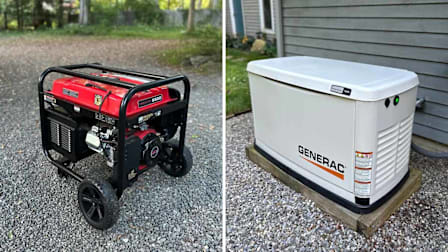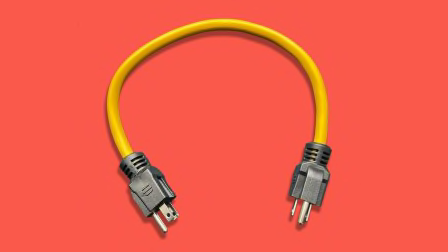How to Choose the Right Size Generator
CR's experts help you select the best type and size of generator to keep the electricity flowing, whether you have occasional or frequent power outages
When you shop through retailer links on our site, we may earn affiliate commissions. 100% of the fees we collect are used to support our nonprofit mission. Learn more.

When the power goes out, whether due to a hurricane, heat stress on the power grid, or just one downed tree, the right generator can be a lifesaver. Because of this, you should regularly check and maintain your portable generator to ensure it operates when needed—especially before a severe weather emergency.
How Do I Calculate What Size Generator I Need?
To determine the size of generator you need, make a list of the appliances you want to power and add up their wattages. And here’s a tip: If you’re considering a portable generator, don’t spring for one that produces a lot more power than you’ll be using.
“There’s no need to go larger unless you want to be able to power more in a pinch and are comfortable with needing to keep more gas on hand,” says Paolo Fu, a Consumer Reports test project leader. Some of the larger portable generators in our ratings can burn through about 20 gallons of gasoline per day.
Depending on the size generator you need, you may have a choice between a traditional portable generator and an inverter generator, which electronically throttles the engine up and down to supply power more efficiently. “If you’re willing to pay more up front for a quieter and more fuel-efficient unit, potentially saving down the road if you use it often, then look at inverters,” Fu says.
The interactive tool below will help you estimate how powerful a generator you need. Just click on a type of generator to get a sense of what appliances you can run with it. The wattages for each type of appliance are general guidelines and may vary from what you have in your home. Also keep in mind that some appliances—air conditioners, refrigerators, and sump pumps, for instance—draw a lot more power at the moment they’re cycling on. These surge watts can throw off your calculations if you don’t account for them.
What a Generator Can Power
Click on any type of generator below to see what it will run in your home.
Recreational
Inverter
Inverter
or Portable
Standby
Another way to think about your generator choices is to consider how often you’re likely to need one, and for how long. That’s unpredictable to an extent, of course, but think about the outages you experienced in the past and what devices you needed to power. Then see which of the three power-outage scenarios below matches your situation.
You can click on any generator type to jump down to a list of its pros and cons, as well as specific product recommendations.
Best Generators for Frequent Power Outages
If you regularly experience power outages—and when the power goes off, the outages are prolonged—you should consider a:
These generator recommendations probably apply if you live in an area prone to severe weather events, such as blizzards, ice storms, tornadoes, and hurricanes, where a large number of homes may be affected at the same time.
Home standby generators, large inverter generators, and large portable generators have enough juice to power your entire household, and they can connect directly to your home’s circuit breaker panel. This allows you to control and run appliances that are hardwired, such as central heat and air conditioning, well pumps, sump pumps, electric ranges, and water heaters. (If you have any of these and you need them to work in a power outage, you’ll need a transfer switch installed at your breaker box to hook up a large portable or inverter generator.)
A licensed electrician should be able to handle the job, but be sure to budget for that installation cost when considering the cost of the generator. A home standby generator also needs costly professional installation, which usually includes a transfer switch.
Best Generators for Occasional Power Outages
If your power outages are sometimes sustained, but not typically, and you don’t want to spend many thousands on a home standby generator, you should consider a:
Unless you experience numerous power outages a year, you might not be willing to spring for the $10,000 or more it can cost to buy and install a home standby generator. You can save thousands of dollars if you’re willing to pull your large inverter or portable generator out of a garage or shed and hook it up during the outage. You’ll still want to budget to have a transfer switch installed.
Best Generators for Rare Power Outages
If your power outages are rare but you still want a generator for some peace of mind and to power a few important items, you should consider a:
Midsized inverter generators have ample power to run a fridge and a window AC or space heater, as you can see in our interactive tool. Small recreational models are compact enough to toss into the back of a pickup to power a TV and cooktop or a small fridge at a tailgate. They can also charge phones and laptops, or power lamps and small kitchen appliances.
Generator Types
Here’s what you need to know about each type of generator, along with info on specific products that do well in Consumer Reports’ testing.
Large Inverter Generator
Wattage: 5,000 watts to around 7,500 watts
Cost: $1,300 to $7,000
Pros: Large inverter generators produce enough energy to run a refrigerator, lights, and other essentials, such as a furnace or small central air conditioning unit. They can be connected to your breaker panel to run hardwired equipment, such as a well pump. They’re quiet and produce steady power, which is ideal for sensitive electronics, such as stereo equipment. And they’re fuel-efficient.
Cons: They’re expensive. Only models costing $1,800 or more perform well enough in our tests to warrant serious consideration. And that connection to your home’s electrical panel will add significantly to the cost. You’ll also need to keep plenty of stabilized gasoline on hand.
Midsized Inverter Generator
Wattage: 2,000 to around 3,500 watts
Cost: $500 to $2,400
Pros: Midsized inverter generators are quiet and lightweight. (Most models weigh less than 150 pounds.) They’re also efficient, capable of keeping the fridge running and the lights on for 8 to 25 hours using only 2 to 3 gallons of gas.
Cons: These inverter generators can generally power only 110-volt items with a standard two- or three-prong plug, ruling out well pumps and heating and cooling equipment. You can now find special 110-volt transfer-switch kits, but the installation cost makes them an impractical choice because you could opt for a portable generator with a 220-volt transfer switch for the same amount of money.
Small Inverter Generator
Wattage: Up to 2,000 watts or so
Cost: $450 to $1,600
Pros: Small inverter generators are lightweight, typically coming in around 60 pounds. They are extremely quiet, have no installation costs, and are easy to store and transport. You can pair most units to increase output. Many come with user-friendly features such as fuel-level indicators and smartphone apps. And you can use them while camping or tailgating to run anything from a TV to a fridge.
Cons: These generators have enough capacity to power a fridge, some lights, and a phone charger, but not much else. They can’t be connected to a circuit breaker panel or used to power any device that doesn’t have a standard plug. The most expensive models cost as much as a portable generator with more capacity.
Large Portable Generator
Wattage: Up to 8,500 watts
Cost: $950 to $2,000
Pros: Portable generators can provide great value—you get a lot of power for the money. Some large models produce enough energy to meet all a home’s power demands. They can be connected to a breaker panel with a transfer switch to run hardwired equipment, such as a well pump.
Cons: Making the connection to your home’s circuit breaker panel can cost several hundred dollars. Large portables are also noisier than large inverter generators and home standby generators. They usually run on gasoline only and use a lot of it compared with inverters. And they’re bulky; many weigh around 250 pounds. They shouldn’t be used in rain or snow without protection, such as an open-sided tent.
Home Standby Generator
Wattage: Up to 20,000 watts
Cost: $2,000 to $6,000
Pros: Home standby generators are permanently installed (usually next to the house) and kick on automatically during an outage to provide uninterrupted power. They can power everything in a typical home simultaneously, up to their maximum output. Standby generators can be set up to run indefinitely on natural gas or propane. There’s no need to connect cables, flip a switch, or start the engine.
Cons: With few exceptions, standby generators are more expensive than other types of generators. Installation can be complex, including building a stable concrete footing and running both gas and electrical connections. Installation costs run into the thousands—and those costs are not included in the prices we list here. These generators can’t be installed in low-lying areas prone to flooding—and can’t be moved if they do flood.
Using a Generator Safely
Consumer Reports tests only portable generators with carbon monoxide (CO) safety technology—that is, a built-in sensor that triggers an automatic shutoff if carbon monoxide builds up to dangerous levels in an enclosed space. We recommend that you only use a generator with this feature.
With any generator, it’s extremely important to follow safe practices, as described in detail by the Consumer Product Safety Commission. You should regularly check and maintain your portable generator to ensure it operates when needed, especially before a severe weather emergency. Never operate a generator indoors, including in a garage or carport. Operate your generator a minimum of 20 feet from your home with the exhaust directed away from it, as well as from any windows, doors, and AC units.
































